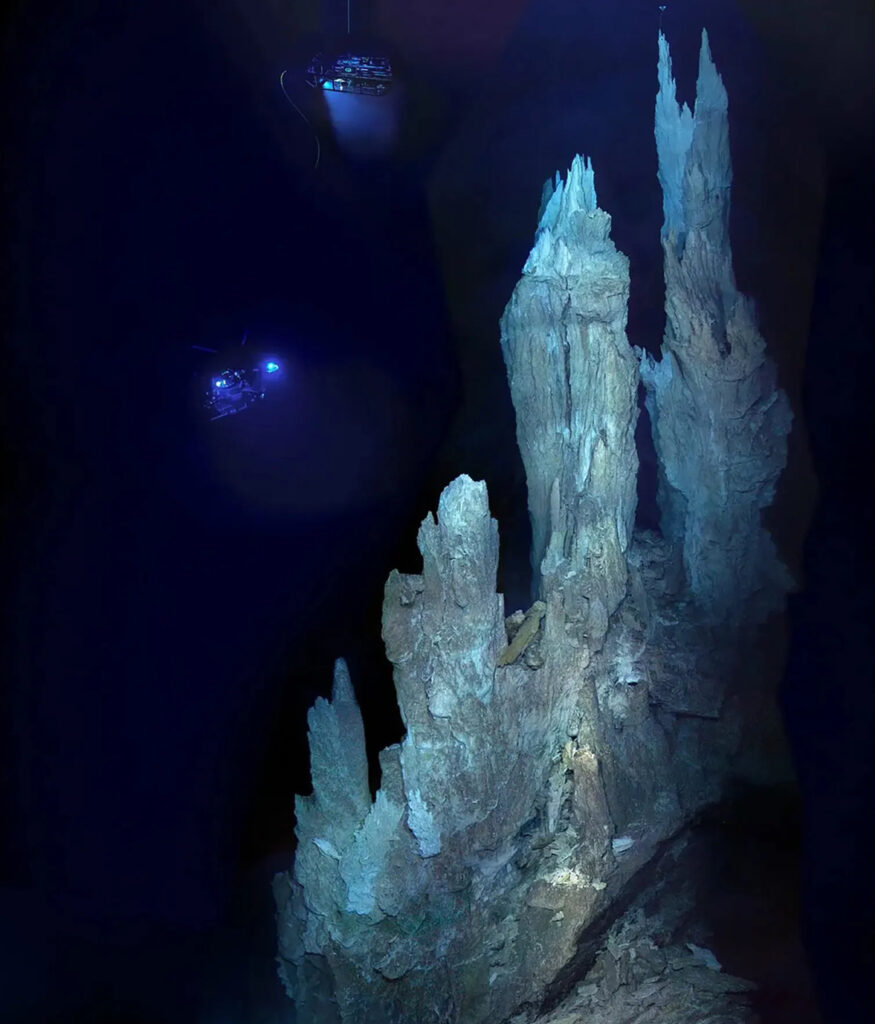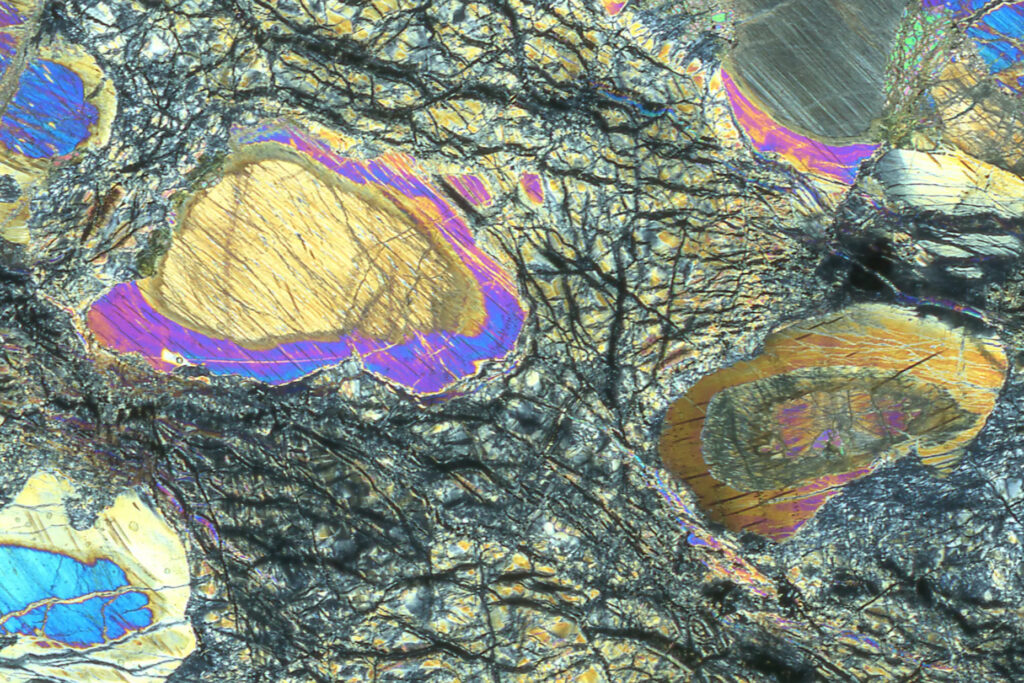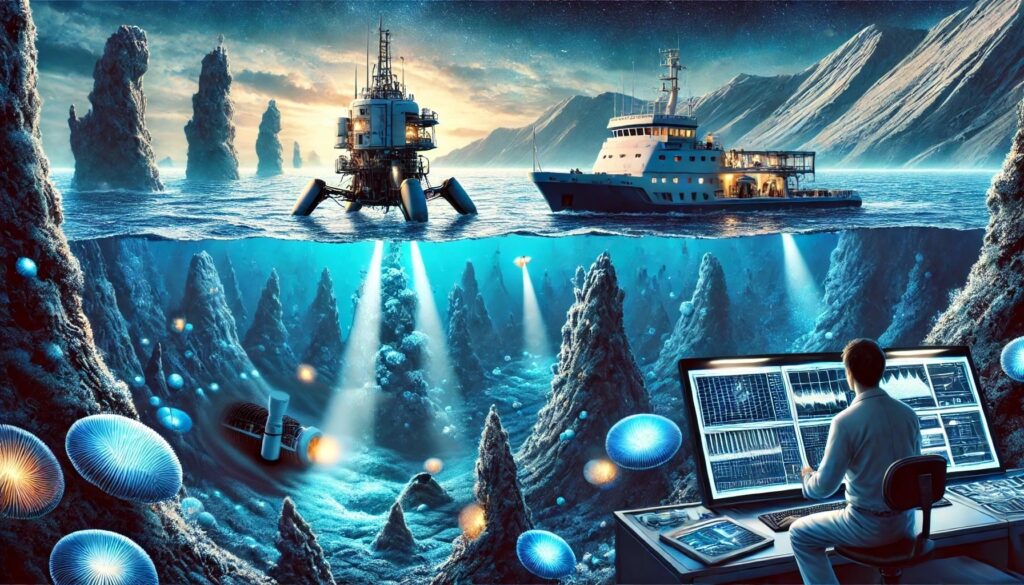ChatGPT:
🧬 Expanded Summary: Ship Brings Rocky Clues to Life’s Origins Up From Ocean’s ‘Lost City’
🌍 Overview of the Expedition
The article details a groundbreaking scientific expedition that focuses on exploring the deep seabed of the Mid-Atlantic Ridge, specifically at a site known as the Lost City. This area is thought to harbor important clues about the origin of life on Earth. A 30-person team succeeded in drilling deep into the ocean floor, extracting an unprecedented sample of rocky material from Earth’s mantle. These rocks are believed to hold significant information regarding the geochemical processes that could have contributed to the formation of life billions of years ago. The expedition is hailed as a major achievement in the field of geosciences, particularly in the ongoing search for evidence supporting theories about how life began on our planet.
The Mid-Atlantic Ridge is a key geological site where volcanic activity and hydrothermal springs create unique conditions. These conditions might have nurtured early life, offering clues not only about Earth’s history but also about potential life on other celestial bodies.
🚢 The Importance of the Lost City Hydrothermal Field
The Lost City hydrothermal field, discovered in 2000, is an extraordinary location within the Mid-Atlantic Ridge. Unlike previously studied hydrothermal systems, the Lost City does not emit the scalding hot, mineral-laden water typically found at such sites. Instead, it is characterized by cooler fluids and larger, more prominent structures, including spires that reach heights comparable to a 20-story building.
The Lost City hydrothermal field differs from “black smoker” chimneys, which are infamous for their extremely high temperatures and dark mineral plumes. The cooler environment of the Lost City has made it particularly intriguing for scientists studying the origins of life, as it matches theories proposed by some researchers, including Michael J. Russell, a geochemist at NASA’s Jet Propulsion Laboratory. Russell suggested that cooler, alkaline hydrothermal systems like Lost City may have been ideal for fostering the chemical reactions that led to the formation of life.
This difference in temperature and chemical composition may have created a more favorable environment for nurturing the geochemical reactions essential to life’s beginning. The Lost City’s discovery has led to heightened interest in similar hydrothermal systems, not only on Earth but also in the study of other planetary bodies that may harbor life under similar conditions.
🔬 Drilling and the Mantle: A Scientific First
The most remarkable outcome of this expedition was the successful retrieval of an extensive section of rock from beneath the seafloor, reaching into Earth’s mantle. The mantle lies beneath the crust and extends all the way to Earth’s core. It is the largest part of our planet, but it remains one of the least understood due to its inaccessibility. The mantle plays a crucial role in shaping Earth’s surface, contributing to the movement of tectonic plates, the formation of mountains, and the occurrence of earthquakes.
Drilling deep into the mantle and extracting a nearly mile-long rock sample was an extraordinary achievement. It marks the first time such a large, continuous section of mantle rock has been collected for scientific study. This core sample, measuring 1,268 meters in length (about four-fifths of a mile), is the longest of its kind and represents a treasure trove of information for geoscientists.
The retrieval of the core was made possible by the International Ocean Discovery Program (IODP), a collaborative research effort involving over 20 countries. The IODP utilizes a specialized drilling ship, originally designed for oil exploration, that can bore into the ocean floor and extract cylindrical samples of rock and other materials. The ship is equipped with advanced drilling technology, including a 200-foot derrick that lowers a hollow drill into the seabed.
One of the expedition’s most exciting aspects was how smoothly the drilling process went. According to Dr. C. Johan Lissenberg, the lead author of the study and a petrologist at Cardiff University, the core samples came up relatively easily despite the challenges of drilling in such a harsh environment. Typically, the rocks in the mantle are prone to fracturing, which can jam the drill and slow down the process. However, the team was delighted to see sample after sample being successfully extracted, likening the experience to “kids in a candy store.”
🧪 Understanding the Geochemical Processes
The extraction of mantle rock from the Lost City region opens up new possibilities for understanding the geochemical processes that may have led to the emergence of life on Earth. For decades, scientists have speculated that the unique conditions found in hydrothermal vent systems like those at the Lost City might have played a role in facilitating the complex chemical reactions that gave rise to early life.
These vents are rich in minerals and are capable of producing energy through the interaction of hot, alkaline water with cooler seawater. This energy could have fueled the synthesis of organic molecules, which in turn may have led to the development of the first living organisms. Scientists have long believed that these early life forms thrived in environments similar to the Lost City, where the right mix of chemicals and conditions existed to support life.
By analyzing the rocks from the Lost City, scientists hope to uncover new information about the specific geochemical reactions that occurred there and how they may have contributed to life’s beginnings. The data collected from these samples could also provide insights into the geological history of the mantle, including how it has shaped the Earth’s surface over millions of years through processes such as plate tectonics and volcanic activity.
🌌 Implications for Extraterrestrial Life
The study of the Lost City has broader implications beyond Earth, particularly in the search for life elsewhere in the universe. The conditions at the Lost City resemble those thought to exist on other celestial bodies, such as Europa (a moon of Jupiter) and Enceladus (a moon of Saturn). Both of these moons have icy surfaces and are believed to harbor subsurface oceans with hydrothermal activity, making them prime candidates in the search for extraterrestrial life.
The rocks retrieved from the Lost City could help scientists better understand how life might arise in similar environments on other planets or moons. If the geochemical processes observed at the Lost City are found to be essential to life’s origins, it could provide a blueprint for where and how to search for life beyond Earth. This connection between deep-sea exploration and astrobiology underscores the significance of the expedition’s findings.
🧑🔬 Future Prospects and Continued Research
While the analysis of the rock samples is still in its early stages, researchers are optimistic about the potential for new discoveries. The scientific community expects that it will take years of detailed study to fully understand the significance of the data collected from the Lost City. Nevertheless, the successful retrieval of such a large, intact section of mantle rock represents a significant step forward in the field of geosciences.
The expedition’s findings could transform our understanding of Earth’s geology, the origins of life, and even the potential for life beyond our planet. As Dr. Frieder Klein, a member of the expedition team from the Woods Hole Oceanographic Institution, stated, the retrieved samples are a “treasure trove” that will enable researchers to systematically study the processes that may have given rise to life on Earth.
In the coming years, scientists will likely uncover new insights into the mantle’s composition and its role in shaping Earth’s surface. Additionally, the study of these samples may help researchers refine their models of how life could originate in similar environments on other worlds, furthering the search for extraterrestrial life.

🔑 Key Concepts for Understanding
- Lost City: A hydrothermal field in the Mid-Atlantic Ridge characterized by cooler waters and tall spires, unlike the “black smoker” hydrothermal systems. It is a key site for studying life’s origins.
- Mid-Atlantic Ridge: A major underwater volcanic mountain range where new oceanic crust is formed. It is a prime location for studying geological processes and life-forming environments.
- Earth’s Mantle: The layer between Earth’s crust and core. The mantle is crucial for understanding tectonic activity and geological processes but is difficult to study directly due to its inaccessibility.
- Hydrothermal Vents: Openings in the seafloor where heated water rich in minerals is expelled. These environments may have been the cradle for early life on Earth.
- Geochemical Reactions: Chemical processes driven by the unique conditions in hydrothermal systems that could have led to the formation of organic molecules and life.
- Extraterrestrial Life: The study of the Lost City and its geochemical processes may help inform the search for life on other planets and moons with similar environments.
- International Ocean Discovery Program (IODP): A global scientific research collaboration that uses advanced drilling technology to explore the Earth’s oceans and retrieve samples from the deep seabed.

FAQs
Q: What is the Lost City, and why is it important?
A: The Lost City is a hydrothermal field in the Mid-Atlantic Ridge, featuring towering spires and cooler waters compared to other deep-sea hydrothermal systems. It is important because scientists believe it could hold clues to the origin of life due to its unique geochemical conditions that might have supported early life on Earth.
Q: What was the main goal of the recent expedition to the Lost City?
A: The primary goal was to drill deep into the ocean floor near the Lost City to retrieve rock samples from the Earth’s mantle. These rocks may provide insights into the geochemical processes that contributed to the origin of life billions of years ago.
Q: How deep did the researchers drill, and what did they retrieve?
A: Researchers drilled nearly a mile into the seabed, retrieving a rock core that measured 1,268 meters (approximately four-fifths of a mile). This is the longest and most comprehensive sample ever collected from the Earth’s mantle.
Q: Why are the mantle rocks significant for the study of life’s origins?
A: The mantle rocks hold vital information about the chemical reactions that may have occurred in deep-sea environments billions of years ago, which could have sparked the formation of early life on Earth. Studying these rocks can help scientists understand the conditions that fostered life.
Q: How do hydrothermal vents like those at the Lost City relate to the origin of life?
A: Hydrothermal vents, where heated, mineral-rich water interacts with cold seawater, create environments that could have fueled the chemical reactions necessary for life. The Lost City, with its cooler, alkaline waters, offers a unique setting for studying these reactions.
Q: What challenges did the expedition face in retrieving the rock samples?
A: Drilling into the mantle is extremely challenging because the rocks tend to fracture and jam the drill. However, the team was surprisingly successful, bringing up sample after sample with relative ease.
Q: What makes the Lost City different from other hydrothermal systems?
A: Unlike “black smoker” vents, which emit extremely hot, mineral-laden water, the Lost City features cooler waters and larger spires. These conditions are believed to be more conducive to the chemical processes that may have led to life’s formation.
Q: How could this research help in the search for extraterrestrial life?
A: The conditions at the Lost City are similar to those that might exist on moons like Europa and Enceladus, which have subsurface oceans. By understanding how life could arise in such environments on Earth, scientists can better guide their search for life elsewhere in the solar system.
Q: What is the International Ocean Discovery Program (IODP)?
A: The IODP is a global research collaboration involving over 20 countries. It uses advanced drilling ships to explore the Earth’s oceans and retrieve rock samples from the deep seabed to study geological processes and the history of the planet.
Q: What are the next steps in the research?
A: Scientists will spend years analyzing the rock samples retrieved from the Lost City to uncover new information about the Earth’s mantle, geochemical processes, and how these may relate to the origins of life on Earth and potentially on other planets.

